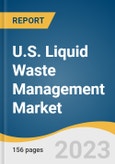According to the U.S. Environmental Protection Agency (EPA), around 20% of facilities in small communities have improper wastewater treatment. The government is taking initiatives to improve the sanitation systems in rural areas that are not connected to the central wastewater sewer networks.
Additionally, rising environmental and public health safety concerns are anticipated for the implementation of stringent rules and regulations that are likely to increase the demand for onsite as well as offsite wastewater treatment plants. For instance, U.S. EPA revised the regulations of poultry, metal finishing, and textile industry with new effluent limitations in September 2021.
Moreover, technological developments and new investments in the wastewater treatment infrastructure are likely to drive the growth of the country’s waste management capabilities. For instance, there are around 32 new construction projects for treatment plants in North America. The City of Evansville, Indiana, is planning the construction of a new treatment plant with an investment of USD 177 million. It is expected to complete by 2025.
The COVID-19 outbreak had a mixed impact on the growth of the waste management market. While due to the limited manufacturing activities during lockdowns, industrial waste generation declined and residential water usage increased which led to the residential water generation spike. Over the forecast period, with the resumption of industrial activities, the market is anticipated to witness strong growth.
Companies in the industry are focusing on mergers & acquisitions, joint ventures, product launches, and expansions to increase market penetration. For instance, in April 2022, Skanska signed a contract with R.J. Industries, Inc., as a part of a joint venture to work at a wastewater resource recovery facility in NY, USA, which will enhance the capacity of the city wastewater management.
U.S. Liquid Waste Management Market Report Highlights
- The centralized waste treatment (CWT) facilities segment held the largest revenue share of over 77.6% in 2023. Centralized treatment plants are large-scale facilities that treat wastewater and serve large municipal or regional areas
- Commercial sector is anticipated to witness a significant CAGR over 2.0% from 2024 to 2030, attributed to the growing number of cafes, restaurants, offices, medical facilities, recreational centers, etc.
- Municipal source segment held the largest revenue share of over 71.1% in 2023. The municipal segment comprises residential and commercial wastewater, which includes cooking, bathing, washing, etc.
- The treatment segment held a revenue share of over 51.7% in 2023, attributed to the development of new technologies and rising infrastructure for treatment facilities
- In April 2021, Veolia and Suez announced coming to an agreement and the merger of the two companies, with the majority of Suez shareholders will be French. This is expected to help Veolia to expand in new verticals and geographies
Table of Contents
Companies Profiled
- Veolia
- Waste Management Solutions
- Clean Harbors
- Clean Water Environmental
- DC Water
- Covanta Holding Corporation
- Stericycle Inc.
- US Ecology Inc.
- Republic Services, Inc.
- Hazardous Waste Experts
Methodology

LOADING...
Table Information
| Report Attribute | Details |
|---|---|
| No. of Pages | 156 |
| Published | November 2023 |
| Forecast Period | 2023 - 2030 |
| Estimated Market Value ( USD | $ 26.7 Billion |
| Forecasted Market Value ( USD | $ 29.8 Billion |
| Compound Annual Growth Rate | 1.6% |
| Regions Covered | United States |
| No. of Companies Mentioned | 10 |









